History and accessibility: a lift at the Colosseum
Elena Colombetti & Maddalena Parotelli
This article first appeared in Elevatori Magazine No. 5/2023
An iconic equipment, in one of the symbols of History, the one with a capital ʻHʼ. The new lift installed at the Colosseum in Rome has, like the building itself, a great story to be told.
Five years of work, major architectural constraints, the need to impact in the best way possible one of the oldest and most visited buildings in the world, a symbol of Rome and the whole of Italy. Marco Patrignani, President of the Orchestra Italiana del Cinema (OIC), the commissioning body of the work, and Franca Borzaga, Executive Board Member of Metal Working, the company that was responsible for the design and installation of the metal shaft structure of the
system, talk us through it all.
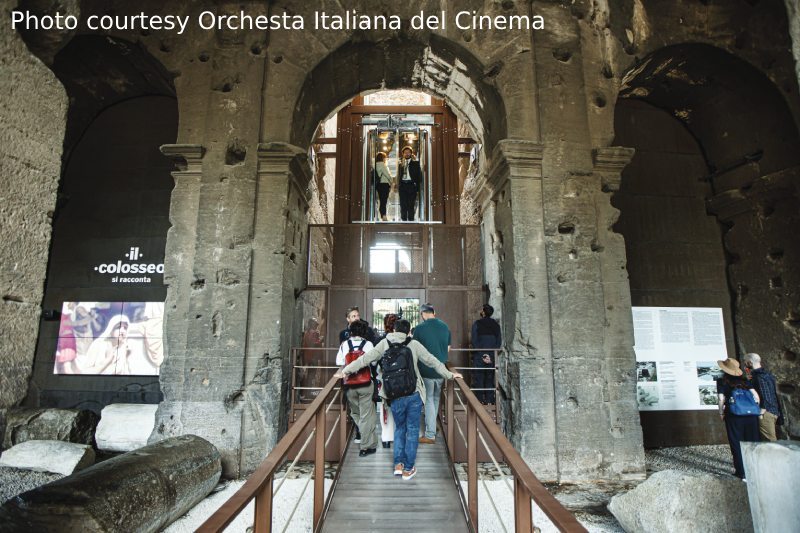
The new lift installed at the Colosseum.
Mr. Patrignani, can you tell us the story of this iconic equipment?
This lift was born from a dream realised through an extraordinary and unrepeatable artistic and cultural event. A virtuous model of collaboration between a major
institution and a Symphony Orchestra. In fact, this marvellous jewel of technology was the result of the synergy between the Orchestra Italiana del Cinema (which I
chair and founded in 2009 inside the historic Forum recording studios, founded by Maestro Ennio Morricone), whose mission is to promote and enhance the great tradition of Italian and international film music across the globe, and the Archaeological Park of the Colosseum. The aim was to bring life to the inside of the XXVII fornix of the Colosseum, with a new panoramic lift that would allow all visitors (including disabled visitors, those with reduced mobility, pregnant women, etc..) to reach the third level of the amphitheatre and fully enjoy the beauty of the worldʼs most famous monument.
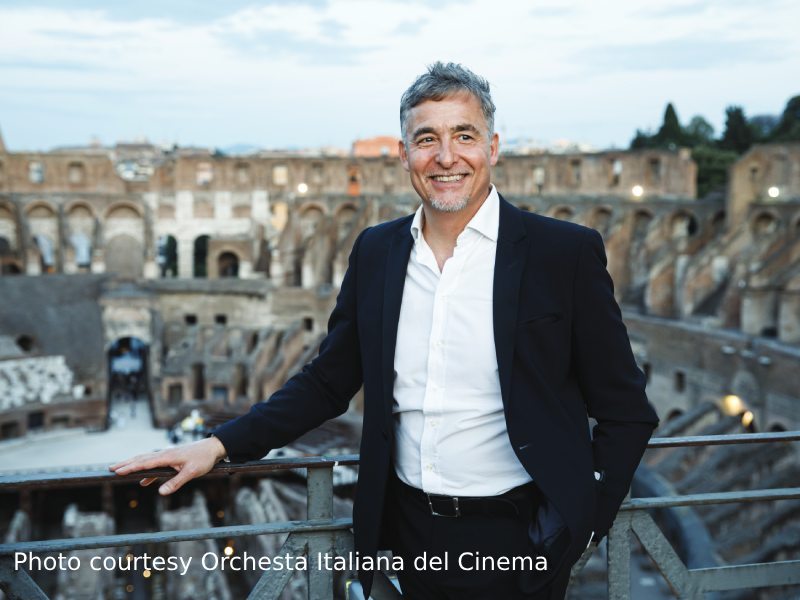
Marco Patrignani, President of the Orchestra Italiana del Cinema.
As a man involved in the world of music and film, I would never have thought that I would personally follow the construction of a new lift at the Colosseum, from the design phase to its inauguration. It took five long years to ensure that a mighty structure of iron and glass could give joy to millions of visitors from all over the world, to ensure that everyone, including those with reduced mobility or physical difficulties, could access the highest floors of the monument, undoubtedly enjoying one of the most beautiful views in the world.
How did the idea for the project come about and what was the role of the Orchestra Italiana del Cinema?
The idea first came about in 2018, when the Colosseum Archaeological Park approved the screening of Ridley Scottʼs masterpiece ʻThe Gladiatorʼ in the arena of the Flavian Amphitheatre. The film was to be accompanied by music from Hans Zimmer performed live by 200 musicians and choristers of the Orchestra Italiana del Cinema, perfectly synchronised with the entire film and in the presence of Oscar winner Russell Crowe. It was a once-ina-lifetime event which, through collaboration with Rotary International, the World Health Organization, UNICEF and the Bill and Melinda Gates Foundation, raised more than $450,000 for the ʻEnd Polio Nowʼ campaign to eradicate Polio from the world.
The extremely rare approval of events inside the Colosseum provides, in addition to the unavoidable, objective and concrete function of solidarity, an important economic commitment (in the form of sponsorship) aimed at works in favour of the monument. This was the beginning of my commitment as President of the Orchestra Italiana del Cinema, to create a new lift to ensure access to the Colosseum.
The important sponsorship agreement included full compliance with the instructions of the Archaeological Park, which actively cooperated at all stages, respecting the specific nature of the site, harmonious insertion into the monument in the indicated spaces, protection of the existing historic masonry, and total reversibility of the work. My heartfelt thanks go in particular to Dr. Alfonsina Russo, Director of the Colosseum Archaeological Park and her extremely efficient staff, without whom this extraordinary project could not have been completed.
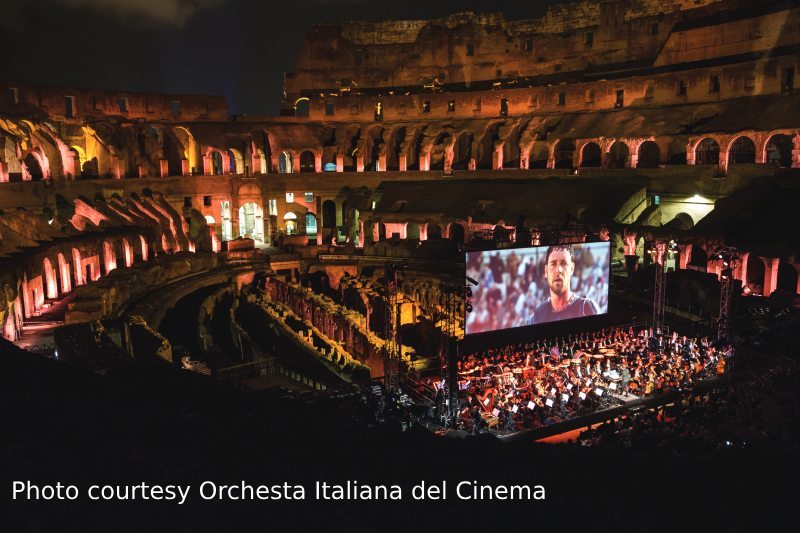
An image of the evening (June 2018) when the film ʻGladiatorʼ was screened at the Colosseum,
with music performed live by the Italian Cinema Orchestra.
A work with a strong artistic sense. Could you tell us about that?
Definitely a strong artistic significance, just think that this is the first lift literally born from music! So in some way it is a small miracle that sound, notes, musicians, instruments, and their powerful creative energy gave birth to this mighty structure. It is as if it were built with the power of emotions and dreams, which seem ethereal but are in fact extremely powerful. Art envelops this project, just think that the official video we made is accompanied by an original soundtrack created by the Orchestra Italiana del Cinema.
The design approach also had to be creative. First of all, because of the enormous responsibility (and opportunity) to design a new lift inside the Colosseum with the best aesthetic, technological, and structural solution, with minimal impact on the structure. Secondly, to overcome all the logistical, bureaucratic, and technical difficulties, not to mention those related to the pandemic which had started and which of course brought significant consequences in terms of construction time
and cost. But we did it, thanks to the active cooperation of a great team.
A lift that has its foundation in a deep cultural heritage…
Most people in the world know about the Colosseum, but few, very few, have had the opportunity to really get to know it. It is a place that is not only iconic but also unique in historical terms. For me personally, it has been an honour to serve this extraordinary and powerful creature albeit in a small way. An incredible structure built in just 10 years, and which has lasted for more than 2,000 years. How was this possible? With a trick. Vespasian engineers repeated something they knew how to do very well, and that was the arch. It is as if they had superimposed several aqueducts.
This way the forces were discharged perfectly to the ground. In short, if the Pyramids are ʻfullʼ (of stone blocks), the Colosseum on the other hand is empty. Not surprisingly, we often hear the quote, “As long as the Colosseum exists, Rome will also exist; when the Colosseum falls, Rome will also fall; when Rome falls, the world will also fall” (Bede the Venerable, 8th century CE).
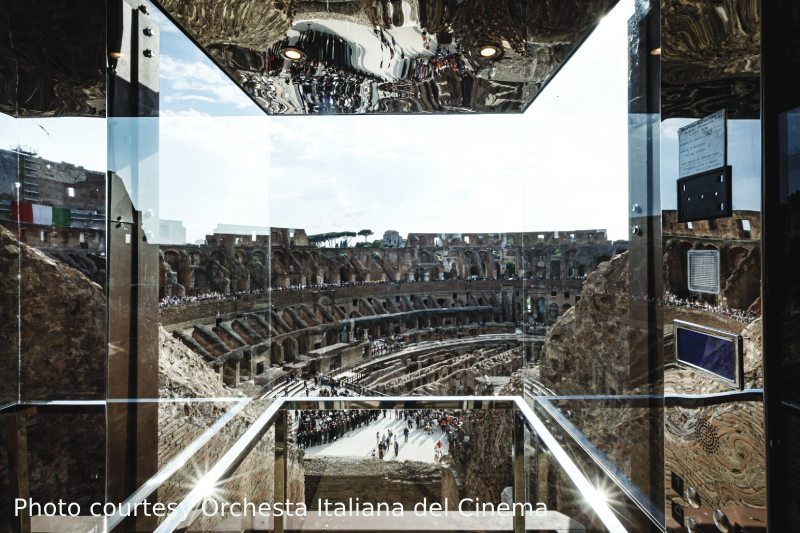
The new lift installed at the Colosseum.
By the way, the Colosseum, even in ancient times housed hoisting machines for lifting beasts into the arena…
Thatʼs right. The old lift – a goods hoist is still there on the left side of the arena floor where the concert and opening ceremony took place. Obviously, this is a faithful reconstruction made recently of the original. The dimensions of the machinery correspond to those obtained from traces left in the tufa walls in the basement of the Colosseum. The cage measures 180 cm x 140 cm and has an internal height of one meter.
The ascent, approximately 7 meters high, was achieved with 15 turns of a winch propelled by 8 men working on two floors (each 1.60 meters high): 4 below and 4 above. Loads of up to 300 kg could be lifted.
I canʼt deny that, from the very beginning of the project, I thought a lot about the relationship with the old lift systems of the Colosseum. The beautiful thing is that in terms of essentiality and linearity, the structure of the new system we built is reminiscent of the forms of these old lifts. Seeing is believing!
Dr. Borzaga, can you tell us about your contribution to the new system from a technical point of view?
The support structure of the new lift car was conceived and designed according to three important criteria. The first is architectural in nature. The aim was always to provide passengers with a unique experience during transportation particularly to the upper levels. In fact, the completely unobstructed car allows a view of the inside of the fornix XXVII and a unique arrival view. The second aspect is respect for the five pillars of restoration to create a fully reversible work. The two load-bearing columns, about 23 m high, were designed to be almost completely self-supporting. In fact, they rest laterally on the walls of the fornix XXVII and are constrained to the two landings only. The third aspect is engineering. The design was carried out following the previous two criteria. All structures were designed and fabricated with small-section profiles and assembled on site using bolted joint components, making it possible for the structure to fully respect the areas that remained open to the public during all phases of installation.

Franca Borzaga, Executive Board Member di Metal Working, l’azienda che si è occupata della progettazione e dell’istallazione dell’incastellatura metallica dell’impianto
How long did it take for the design, fabrication, and installation of this system from planning to commissioning? What techniques and materials were used, and which regulations were followed?
Planning began in 2019 with the first meetings with the Technical Management and Construction Management, as well as the Art Direction. It was a 3-year journey starting from the early stages of study, moving on to the design and construction phase of the structures to the implementation of the artifacts. Our company is qualified in the design and production of profiles derived from the cold press bending of steel sheet. The know-how we achieved enabled us to bring our expert
knowledge to the implementation of this very important project. We must point out that this capability was recently confirmed by a research and development
project we carried out in collaboration with the University of Trento and the Politecnico di Milano. We will be bringing this experience to the VFA Forum at Interlift 2023.
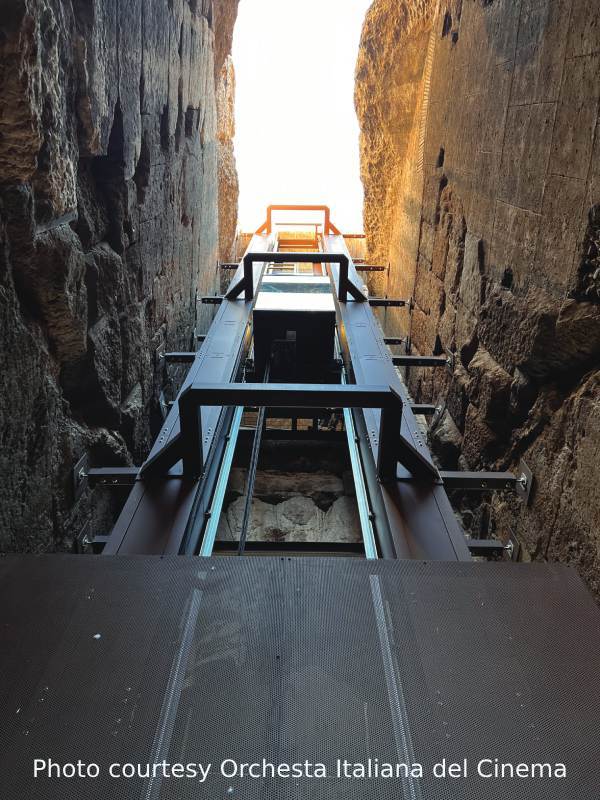
Can you give us some background?
At one point, as we were studying the job order, we came close to being ousted from the project, after a major player in the market arrived, offering to execute the work. But both the management of the Colosseum Archaeological Park and Marco Patrignani (President of the Orchestra Italiana del Cinema, the main sponsor of the work) saw and recognised our professionalism, willingness to work hard and flexibility of execution from the very beginning and expressly wanted to keep us as the sole reference for the metal structures. And so the biggest and most important project in our history (still young, in fact in February this year we celebrated our 15th anniversary) was accomplished.
In such a special context, did you encounter any difficulties?
Working on one of the most important historical sites in the world challenged our awareness that we were facing such grandeur. The joy of leaving our mark allowed us to overcome all our fears. But the team created with all other players was so significant and strong that it allowed us to tackle the project with determination and passion. We could say that the only aspect that could be called difficult was that of operating in an environment which is visited by 30,000 people a day in peak season, an aspect that limited everything related to site logistics, material deliveries, entries, sorting, and so on.
To handle job orders in historic buildings, you need precise working methodologies, you need to follow strict rules. How do you approach these kinds of buildings?
First and foremost, we prioritize accessibility. The goal is to allow everyone, including people with reduced mobility, to reach such memorable places. We did not leave out the emotional component, namely, the ability to give a unique experience to those in the lift car. The knowledge that allowed us to meet challenges like this came from our experience in the field, our recognised skill in design and construction, and our research studies in the field.
As you pointed out, a facility like this is also extremely important from the point of view of accessibility. Can you tell us about your approach to this issue?
Accessibility has always been important to us. Last year, we had a successful collaboration with the Handicrea Cooperative in Trento, Italy (www.handicrea.it). The Handicrea Association is a cooperative aimed at assisting those with disabilities and competently supports people in the daily problems of removing architectural barriers. An interesting example of issues to think about is where the lift control panels are placed, almost always at heights that do not consider the difficulties of those with disabilities. Also, the presence of information describing lifts or assistive devices at all historical sites in Trento, the Trentino-South Tyrol Region, and other regions in northern Italy, to minimize access difficulties. For us and our Team, it has been an experience of growth and awareness which, during the design process, spontaneously spurs us on to consider details, even small ones, but which are essential if we are to ensure accessibility.

